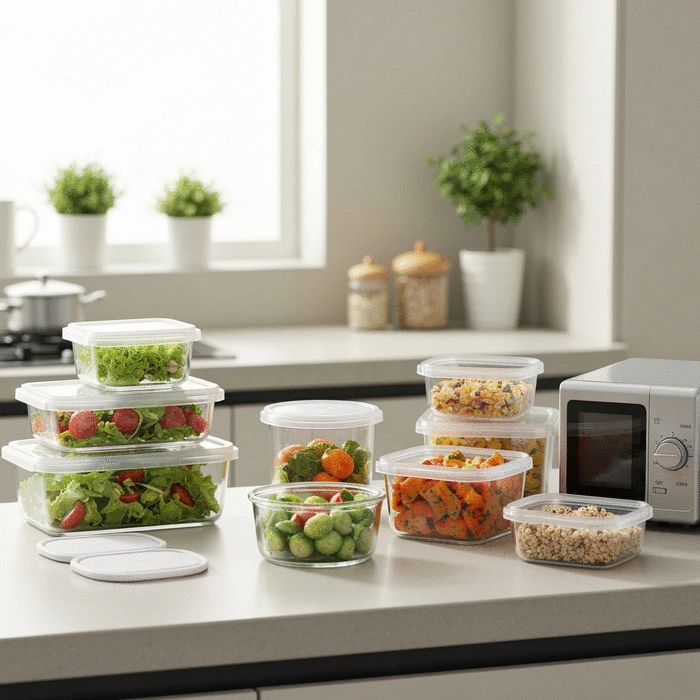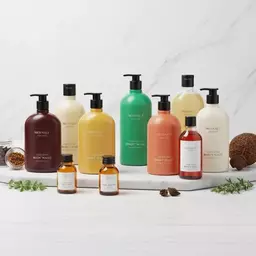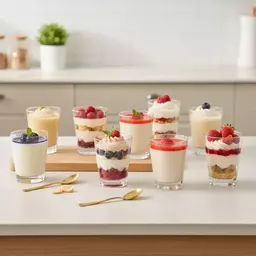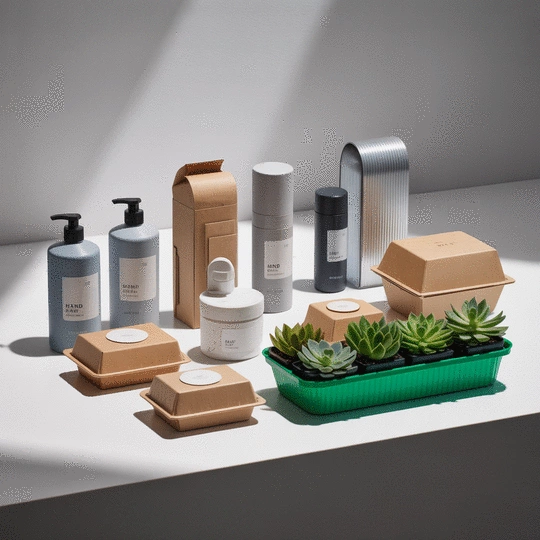Microwave Food Container Safety Tips

Posted on: 2025-10-31
By: Clara Voss
Did you know that using the wrong containers in your microwave can not only ruin your meal but also pose serious health risks? Choosing the right materials is essential for ensuring microwave safety and protecting your health.
What You Will Learn
- Understanding the health risks associated with using unsafe microwave containers.
- Identifying microwave-safe materials like glass, ceramic, and certain plastics.
- Recognizing the importance of BPA-free and non-toxic container options.
- Key practices for selecting safe microwave containers, including checking for microwave-safe labels.
Microwave Container Safety: Safe vs. Unsafe Materials
This visual presents a clear comparison of safe and unsafe materials for microwave use, highlighting key properties and examples for informed choices.
✅ Microwave-Safe Materials
-
•
Glass: Non-reactive, withstands high temperatures.
-
•
Ceramic: Generally safe (no metallic accents).
-
•
BPA-Free Plastics: Designed to resist heat and prevent leaching.
-
•
PET (Polyethylene Terephthalate): Common for microwave-safe containers.
-
•
Polypropylene (PP): Safe up to 160°F.
❌ Unsafe Materials to Avoid
-
•
Polyvinyl Chloride (PVC): Can leach harmful chemicals.
-
•
Containers Not Labeled Microwave-Safe: Untested for heat resistance.
-
•
Metallic Accents/Trim: Can cause sparks and fire hazards.
-
•
Thin, Single-Use Plastics: Often warp, melt, or leach chemicals.
-
•
Styrofoam: Melts and can release harmful substances.
Understanding Microwave Safety: The Importance of Using the Right Containers
When it comes to microwave safety, understanding the risks associated with using the wrong containers is crucial. Many people don’t realize that not all materials are designed to withstand the intense heat and pressure that microwaving can create. Using unsafe containers can lead to leaching harmful chemicals into your food, potentially impacting your health. For more detailed information on general food safety, you can refer to FoodSafety.gov's guidelines.
Additionally, certain types of containers can warp or melt, leading to unsightly messes and potential burns. It’s important to always consider what you’re using to heat your food—it's not just about convenience but also about safety!
Why Microwave Safety Matters
- Health Risks: Microwaving food in unsafe containers may release chemicals into your meals.
- Fire Hazards: Some materials can ignite or cause sparks in the microwave.
- Product Integrity: Using inappropriate containers can compromise the quality and taste of your food.
By prioritizing microwave safety, you can avoid these risks and ensure that your meals are both delicious and safe. The right containers can enhance your cooking experience and provide peace of mind while you heat your food.
What You Need to Know About Microwave-Safe Labels
When shopping for containers, it’s essential to look for microwave-safe labels. These indicators help you identify which products are suitable for microwave use. Common symbols include wavy lines or a microwave icon, both of which signify that a container has been tested for safety under microwave conditions, as highlighted by resources like the FDA's information on microwave ovens.
However, it’s vital to understand that just because a container has a microwave-safe label doesn't mean it’s free from risks. Familiarizing yourself with these labels can help you make informed choices and avoid any potential hazards.
Materials Matter: Choosing the Right Microwave Food Containers
Choosing the right materials for your microwave containers is vital for safety and usability. Not all materials are created equal, and understanding which options are safe can save you from unexpected issues in the kitchen.
Microwave-Safe Materials: An Overview
- Glass: Non-reactive and withstands high temperatures without melting.
- Ceramic: Generally safe, but make sure there are no metallic accents.
- Certain Plastics: Look for those labeled as microwave-safe, generally made to resist heat.
These materials are not only designed for high temperatures but also help preserve the flavor of your food. At Innovative Packaging Solutions, we take great care in selecting materials for our products, ensuring they meet necessary safety standards for both commercial and personal use.
Plastics Under the Microscope: Safe vs. Unsafe Options
Plastics can be tricky when it comes to microwave safety. Not all plastics are suitable for heating, and it’s important to know which ones to avoid. Generally, plastics labeled with the following are considered safe:
- BPA-Free: Free from bisphenol A, a chemical that can leach into food.
- PET (Polyethylene Terephthalate): Commonly used for microwave-safe containers.
- Polypropylene (PP): Often safe up to 160°F, making it ideal for microwave use.
On the other hand, polyvinyl chloride (PVC) and containers not labeled as microwave-safe should be avoided. Knowing these distinctions can help you make choices that prioritize your health and safety. For more information on microwave usage and safety practices, you can consult Health Canada's advice on microwaves.
Exploring BPA-Free and Non-Toxic Container Options
As consumers become more health-conscious, the demand for BPA-free and non-toxic containers has surged. These options help mitigate the risks associated with chemical leaching, offering a safer alternative for heating food.
By opting for BPA-free containers, you support not only your own health but also the environment. At Innovative Packaging Solutions, we are committed to providing packaging materials that are both effective and safe for consumers, ensuring that every meal is a healthy choice!
Frequently Asked Questions About Microwave Container Safety
What are the main health risks of using unsafe containers in the microwave?
Using unsafe containers can lead to the leaching of harmful chemicals into your food, which can pose significant health risks. Additionally, some materials can warp, melt, or even cause fire hazards.
How can I identify microwave-safe containers?
Look for specific microwave-safe labels, often indicated by wavy lines or a microwave icon. Materials like glass, ceramic (without metallic accents), and certain BPA-free plastics (PET, PP) are generally safe.
Why should I choose BPA-free and non-toxic container options?
BPA-free and non-toxic containers help prevent harmful chemicals, such as bisphenol A, from leaching into your food. This choice supports your health and is often more environmentally friendly.
Which materials should I avoid using in the microwave?
Avoid polyvinyl chloride (PVC), containers without a microwave-safe label, items with metallic accents, thin single-use plastics, and Styrofoam. These materials can melt, leach chemicals, or cause sparks.
What is the 'Pro Tip' for selecting microwave-safe containers?
When reheating liquids like soups, opt for glass containers with vented lids. Vented lids allow steam to escape, preventing pressure buildup and enhancing both safety and food quality.
Pro Tip
When selecting microwave-safe containers, always consider your cooking needs. For example, if you're reheating soups or stews, opt for glass containers with vented lids to allow steam to escape and prevent pressure build-up. This not only enhances safety but also improves the quality of your meal!
Recapping Safe Practices for Microwave Food Containers
As we wrap up our conversation about microwave safety, it’s essential to remember the key takeaways regarding safe practices and material choices when selecting containers for your meals. Using the right containers not only protects your health but also ensures that your food stays fresh and tasty!
- Always check for microwave-safe labels: Look for symbols or labels that indicate the container can safely withstand microwaving.
- Prioritize materials like glass and ceramic: These materials are generally safe for microwave use and do not leach harmful chemicals.
- Avoid plastic containers marked with BPA: Opt for BPA-free and non-toxic options to reduce health risks.
- Use vented lids: This allows steam to escape and prevents pressure build-up while cooking.
Incorporating these practices into your routine will not only make your microwaving experience safer but also enhance the overall quality of your meals. At Innovative Packaging Solutions, we are committed to providing you with reliable and safe packaging solutions, whether for food or other purposes. Let’s keep your kitchen and your health a top priority!
Get Informed: Take Charge of Your Microwave Safety Today
Now that you’re equipped with the knowledge on safe practices for microwave use, I encourage you to take a moment to review your current collection of microwave containers. Are they all marked as microwave-safe? Are you using materials that align with the safety guidelines we discussed? Taking charge of your kitchen safety is vital!
Feel free to share your experiences or ask any questions in the comments below. I love hearing from fellow safety-conscious cooks! Let’s create a community that prioritizes health and safety in our cooking practices. Remember, the right packaging goes a long way in contributing to your culinary success!
Recap of Key Points
Here is a quick recap of the important points discussed in the article:
- Always check for microwave-safe labels: Look for symbols or labels that indicate the container can safely withstand microwaving.
- Prioritize materials like glass and ceramic: These materials are generally safe for microwave use and do not leach harmful chemicals.
- Avoid plastic containers marked with BPA: Opt for BPA-free and non-toxic options to reduce health risks.
- Use vented lids: This allows steam to escape and prevents pressure build-up while cooking.
 Choosing the right planting method can significantly impact your gardening success. As a gardener, u
Choosing the right planting method can significantly impact your gardening success. As a gardener, u
 As brands strive to resonate with an increasingly personalized consumer base, the packaging of produ
As brands strive to resonate with an increasingly personalized consumer base, the packaging of produ
 In the world of foodservice, presentation and convenience are key. By embracing microwave-safe desse
In the world of foodservice, presentation and convenience are key. By embracing microwave-safe desse
